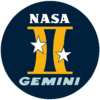- Orbit attitude and maneuvering system
-
The orbit attitude and maneuvering system (OAMS) was a propulsion system used in orbit by the Gemini spacecraft.
Operations
Besides providing rotation control to let a pilot steer the spacecraft, the OAMS provided translation control for the Gemini spacecraft, moving it linearly up, down, sideways, forward or aft relative to a nearby object in space. It provided the spacecraft with the capability of changing its orbit, and of performing rendezvous and docking with another spacecraft. The system was also used at the start of the mission to push the spacecraft away from the spent second stage of the launch vehicle, and on occasion, to augment the retrorockets to bring the craft out of orbit.
The complete OAMS had 16 small rocket engines which burned hypergolic propellants fed under pressure from one monomethylhydrazine fuel, and one nitrogen tetroxide oxidizer tank. All engines were mounted in fixed positions and were run at fixed levels of thrust.
- The eight rotational control engines were mounted off the spacecraft's center of mass around the aft section of the spacecraft's equipment adapter, pointed at 90 degree positions up, down, left and right. These were rated at 25 pounds-force (110 N) thrust and fired in pairs, causing it to pitch, roll, or yaw to control attitude.
- Six of the translational control engines were mounted on the side of the retrorocket module, near the spacecraft's center of mass. These were rated at 100 pounds-force (440 N) thrust. One was pointed in each direction up, down, left or right, while two were pointed forrward to provide aft thrust.
- The two forward translation control engines were mounted on the inside of the aft end of the equipment adapter at the twelve o'clock and six o'clock positions. These were rated at 85 pounds-force (380 N) (reduced from 100 pounds-force (440 N) in July 1962).
Events
During Gemini 8, on March 16, 1966, OAMS engine number 8 became stuck on, resulting in uncontrollable spinning of the spacecraft. The entire OAMS had to be shut down and the mission was terminated prematurely. This resulted in modifications to OAMS to permit engine isolation.
References
Gemini program Missions 
Components Gemini spacecraft · Orbit attitude and maneuvering system · Titan rocket · Agena target vehicle · Gemini space suitLaunch sites Developments Advanced Gemini · Blue Gemini and Manned Orbital Development System · Manned Orbiting Laboratory and Gemini B · Big GeminiCategories:- Gemini program
- United States spacecraft stubs
Wikimedia Foundation. 2010.
